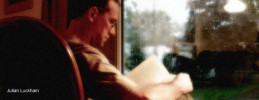
photo by Niko
An ‘Undergrads Read’ Feature
by Morgaine Davidson
One of the most gripping reinventions of the ‘Little Red Riding Hood’ tale, Angela Carter’s ‘The Company Of Wolves’ is an extraordinarily beautiful story of female sexual awakening and transformation.
Each of the stories in the renowned collection The Bloody Chamber is a reinvention of a classic fairy tale or folk story. In Carter’s hands, they grow rich in symbolism and seductive, with her typically poetic use of language and her often intricate patterns of imagery. The collection includes a moving depiction of ‘Beauty and the Beast’, an urban Puss In Boots, and the title story is a reworking of the old ‘Bluebeard’ folk tale. Even as they seduce us, Carter’s stories reveal the primal and bloody core of old tales that were once designed to frighten children into doing what they were told. They take us into the dark corners of the human psyche and explore that which is often taboo. She confronts convention and gender stereotypes in a no-holds-barred verbal fistfight, and emerges clutching this alluring yet unsettling collection in an undeniable victory.
By taking the Red Riding Hood myth and modernising it, Carter turns traditional gender roles on their heads. The first part of her story sets the scene in an unnamed settlement; the phrase ‘one beast and only one howls in the woods by night’ is a chilling opening. The reader is instantly bombarded with line after line of powerfully evocative imagery. She piles metaphor upon simile until we almost begin to buckle under the weight, but the picture painted in our minds is vivid and unequivocal. In this world, the wolves are ‘grey members of a congregation of nightmare’; they belong to the night and to terror. The werewolf is even worse. Carter’s wolf-man is symbolic of sexual appetite, of danger and desire; he is something against which women have been ‘sheltered’ in one form or another for centuries.
In the second part of Carter’s narrative, we follow the footsteps of an unnamed girl who travels through the forest to visit her ailing grandmother. As in the fairy tale, she is wearing a red hooded cloak that ‘has the ominous if brilliant look of blood on snow’. However, we quickly become aware that this is a more mature heroine than the fairy story offers us; she is described as being in that period of limbo when a girl becomes a woman, with pale cheeks and flaxen hair. She is innocent and virginal, but she is also armed with a knife and unafraid. En route to her grandmother’s cottage, the wolf appears to her disguised as a handsome huntsman bedecked in the green of the forest – symbolic of course of life and of rebirth. After accompanying her part of the way through the wood, the wolf-man makes a bet with Little Red: that by using his compass he can navigate the perilous forest and arrive at the cottage before her. His prize, should he win, will be a kiss. She agrees, and the seduction begins.
But in the final dramatic encounter between Little Red and the wolf, the girl displays a maturity and wisdom unknown to his previous victims. By abandoning the ‘safe’ preconceptions taught to her in childhood, she saves her own life and turns the tables on the ravenous carnivore. Here, the wolf-man is the forest, he is the night, he is all that people are supposed to fear. But she gives him the kiss she owes him, and more. They are opposites, dark and light, man and woman, beast and innocent, yet the seduction has been reversed, the power has shifted, and the young girl-turned-woman trusts in her own powerful sexuality for protection.
Through her use of the wolf myth, Carter was able to show that a girl who took her power into her own hands and used it without shame or fear was the only one to tame the savage beast and survive. It is a story of female empowerment, one that enthralls the mind and engages the senses, and for that reason that ‘The Company Of Wolves’ is a compelling read.
Morgaine Davidson is studying for an English and Creative Writing degree at the University of Chichester.
*
If you’re an undergrad and would like to send us a short, reflective piece about one of your favourite short stories, please see the ‘Undergrads Reads’ submission guidelines. We’d love to hear from you.


Hi – mesmerised by the story, I am curious to know the narrative techniques used in Company of Wolves. Did Angela use zero focalisation and psycho-narration?Dos it fit with Seymour Chatman’s Model? Am thirsty to know more about various aspects of narration, anyone can help?
Morgaine,
Great job with your review. You make me want to go out and buy this collection. It’s amazing how each review or event on this website enriches and ties into the type of work I enjoy writing. I’m sure I’m not the only writer who uses or has used Fairy Tale elements in their stories. I think my story is ready to make the rounds (will it be accepted or rejected?) but it will be interesting to see how many elements, if any, I’ve used in telling my story. I’ve heard of this collection and did see the movie but never got around to buying it. Maybe now I will. Thanks again.
Thank you very much, Angela Carter’s collection of stories is very dear to me, and the more people who are able to experience the enjoyment of a beautiful short story, the better! I wish you the best of luck with your story, fingers crossed! It is interesting to observe how many fairy tale elements are included in everyday life, without people even realising it…
Thanks again, and all the best,
Morgaine